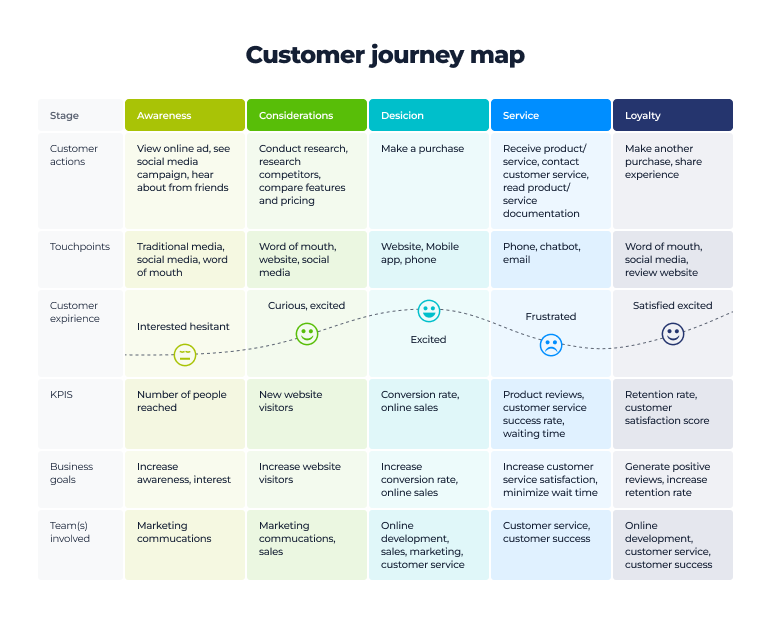An important part of building better relationships with your customers is getting to know the process your customer goes through from prospect to checkout. This involves not only instances when they’re directly in contact with your business, but also stages such as becoming aware of your product, or clicking on a display ad.
This is what customer journey mapping is all about, helping you better understand and build rapport with your customers.
In this article, we outline everything you need to know about customer journey mapping, alongside the best practices for creating your own customer journey map.
So, let’s buckle up and get started with the ultimate guide to customer journey mapping!
What is a customer journey?
Customer journey is a term that describes the process a customer goes through from the moment they first interact with your business until they make a purchase. It's a roadmap of the customer's experience, highlighting their interactions, decisions, and feelings at each stage of the buying process.
Understanding the customer journey is crucial for businesses, and here's why…
- You can tailor your marketing efforts to match the needs and preferences of customers at each stage. This leads to more effective and personalised marketing strategies.
- You can identify areas where they may encounter difficulties or frustration. Addressing these issues can significantly improve overall customer experience.
- Customers appreciate businesses that understand their needs and provide a seamless shopping experience. You can increase customer satisfaction and loyalty.
- You can better inform business decisions, from product development to customer service strategies. This leads to improved business performance.
Customer journey stages
The customer journey is not a single action, but a series of stages that a customer goes through when interacting with a business. Understanding these stages is crucial for creating a seamless and effective customer experience.
Here are the typical stages of a customer journey…

The Awareness stage of the customer journey
This is when a potential customer first becomes aware of your business or product. This could be through a social media post, a blog article, a Google search, or a word-of-mouth recommendation.
The Consideration stage of the customer journey
At this stage, the customer knows about your business and is considering whether your product or service could meet their needs. They might compare your offerings with those of your competitors, ead reviews on websites and social media, or seek more information about your products from the self-service portal or AI contact center.
The Decision stage of the customer journey
This is the critical stage where the customer purchases your product or service.
They've done their research, compared options, and decided that your offering is the best fit for their needs.
The Purchase stage of the customer journey
The customer makes the purchase at this stage. The ease and convenience of the purchasing process can significantly impact their overall experience.
The Retention stage of the customer journey
After a purchase, the customer uses your product or service. They will likely become repeat customers if they're satisfied with their experience.
The Advocacy stage of the customer journey
In the final stage, satisfied customers become advocates for your business, recommending products or services to others and contributing to your business's growth.
Each stage of the customer journey presents unique opportunities for your business to engage with customers and enhance their experience. By understanding these stages, you can tailor your marketing, sales, and customer service strategies to meet customers' needs at each point in their journey.
What is a customer journey map?
A customer journey map is a visual representation or diagram that outlines the complete end-to-end experience of a customer as they interact with a company, product, or service. It depicts the various touch points and interactions a customer has from the initial awareness stage through the purchase process, post-purchase interactions, and potentially even beyond.
Types of customer journey maps
There are several types of customer journey maps, each with its unique focus and purpose. The type of map you choose to create depends on your business goals and the specific insights you're looking to gain about your customers. Let's delve into four main types of customer journey maps…
Current State customer journey map

The Current State customer journey map provides a snapshot of a customer's journey as it is right now. It outlines the existing customer experience, from the first point of contact to the final interaction.
This map is best used when you want to understand the current customer experience and identify areas of improvement.
Pros of the Current State customer journey map:
✅ Provides a clear picture of the existing customer journey.
✅ Helps identify customer pain points and areas for improvement.
✅ Useful for benchmarking and measuring the impact of future changes.
Cons of the Current State customer journey map:
❌ May not provide insights into potential future scenarios or opportunities.
❌ Requires regular updates to remain accurate as customer behaviour and business operations change.
Future State customer journey map

The Future State map visualises the ideal customer journey. It's a projection of how you want your customers to interact with your business in the future.
This type of map is best used when planning strategic changes or aiming to implement improvements to the customer experience.
Pros of the Future State customer journey map:
✅ Helps visualise and plan the desired customer experience.
✅ Useful for setting customer experience goals and objectives.
✅ Can inspire innovative ideas for improving the customer journey.
Cons of the Future State customer journey map:
❌ May not reflect the current reality of the customer experience.
❌ Requires a clear understanding of customer needs and capabilities to be effective.
Day in the Life customer journey map

A Day in the Life map is a detailed look at a customer's daily activities, including interactions with your business and other related activities. This map is best used when you want to understand the broader context of your customer's operations and how your business fits into it.
Pros of the Day in the Life customer journey map:
✅ Provides a holistic view of the customer's daily life.
✅ Helps identify opportunities to integrate your business into the customer's routine.
✅ Can reveal unexpected insights about customer behaviour and needs.
Cons of the Day in the Life customer journey map:
❌ May require more extensive research to accurately represent the customer's daily activities.
❌ A broader focus may dilute the insights specific to your business.
Service Blueprint customer journey map

A Service Blueprint map goes beyond the customer's journey and includes behind-the-scenes activities that enable a positive customer experience.
This map is best used when you want to understand how different parts of your business contribute to the customer journey.
Pros of the Service Blueprint customer journey map:
✅ Provides a comprehensive view of the customer journey and the business operations that support it.
✅ Helps identify inefficiencies in business processes that impact the customer experience.
✅ Useful for aligning different departments around the customer journey.
Cons of the Service Blueprint customer journey map:
❌ Can be complex and time-consuming to create due to the level of detail required.
❌ Requires input from multiple departments which can be challenging to coordinate.

Each of these customer journey maps serves a unique purpose and provides different insights. The key is to choose the type that best aligns with your business goals and the insights you're looking to gain about customers.
You can also leverage tools such as a CRM system. With NetHunt CRM you can easily manage and analyse customer data through features such as…
- Organised customer cards with the timeline of customer communication neatly presented at the side.
- WhatsApp, Instagram, and Facebook messages pulled into the timeline through integrations to get a more complete outlook on customer communications.
- Visualised sales pipeline to help track and nurture prospects along their customer journey.
What’s included in a customer journey map?
A customer journey map includes several key components to provide a comprehensive view of the customer's experience.
- The buying process outlines the stages a customer goes through when purchasing, from initial awareness and consideration to the final decision and post-purchase experience.
- Emotions capture the customer's feelings at each stage of the buying process. They help businesses understand the emotional impact of the customer experience and identify opportunities to enhance customer satisfaction.
- User actions detail the actions a customer takes at each stage of the buying process. They provide insights into customer behaviour and help businesses tailor their strategies to align with customer actions.
- User research captures information that customers seek and the sources they use at each stage of the buying process. It helps businesses understand the customer's information needs and the role of different information sources in the customer journey.
- Solutions are where businesses identify potential improvements to the buying process based on the insights gained from the customer journey map. They include strategies to address customer pain points, enhance the customer experience, and optimise the buying process.
Why do you need a customer journey map?
In today's customer-centric business environment, understanding your customers' experiences and expectations is paramount. A customer journey map serves as a powerful tool to help gain these insights.
Here are some compelling reasons why your business needs a customer journey map…
- Lets you see your business from your customer's viewpoint, helping you understand their needs and buyer motivates.
- Helps identify bottlenecks in the customer experience, allowing for improvements to sales processes and a smoother sales experience for both customers and sales reps.
- Allows you to develop and improve a more complex understanding of sales touchpoints that your customers will journey through. Additionally, you might spot touchpoints that you haven’t yet covered and implement them
- Visualises the customer's emotional journey through your business in a way where data-driven decisions can be made.
- Helps personalise content like never before due to a deeper understanding of customer needs, intents, and interactions with customers.
- Provides significant aid in the process of aligning the different teams and departments working within your company, keeping everyone on the same page when it comes to customers.
- Improves customer satisfaction, driving better customer retention, decreasing CAC and growing your ROI.
- Gives you the ability to identify potential opportunities to differentiate your brand from the competition.
- Helps spot future problems from a mile away, being able to identify a roadblock and start working on the solution before problems arise.
Remember, the customer journey map is not a one-time exercise. It should be regularly updated to reflect changes in customer behaviour, market trends, and business operations.
With a dynamic and up-to-date customer journey map, you can stay ahead of the curve and consistently deliver exceptional customer experiences.
How to create a customer journey map: Customer journey mapping best practices
Creating a customer journey map is a strategic process that requires careful planning, research, and collaboration. It's not just about sketching a diagram. It's about diving deep into your customers' experiences, understanding their needs and expectations, and aligning your business operations to meet these needs.
In the following sections, we'll walk you through the best practices for creating a practical customer journey map.
Set clear objectives for your customer journey mapping
In order for your customer journey map to be able to really have an impact on your business, you first need to become clear on what impact you want it to have.
A few objectives that you could set for yourself are…
- Identify areas where the customer experience can be improved, leading to higher customer satisfaction rates.
- Optimise your sales funnel and marketing strategies to increase conversion rates.
- Improve customer retention rates by ensuring a positive and seamless customer experience.
- Identify opportunities to upsell or cross-sell products and services, increasing revenue.
- Gain insights into customer needs and preferences, informing product development and innovation.
- Tailor marketing strategies to the needs and preferences of their customers at each stage of the journey.
- Improve customer service, ensuring that customers receive timely and effective assistance when they need it.
- Identify inefficiencies in your processes and take steps to streamline them, improving operational efficiency.
- Increase customer loyalty and advocacy.
- Align your operations with customer needs and market trends.
Develop buyer personas and define their goals
In order to be able to understand the customer journey, you first need to understand who your customers are. A buyer persona is a tool that can do just that. It is a semi-fictional outlined description of the person who best encompasses your target audience.
We have a whole article on our blog dedicated to helping you define your buyer persona, but here’s the short rundown of the steps from that article…
- Discover your audience
- Determine what pains your product alleviates
- Identify triggers and potential sales objections
- Discover your existing audience
- Bring personas to life
- Organise the persona into a neat template
To find more details, check out the article...

List all the touch points between you and your customers
After you find out who your customers are, it’s time to find out what makes them tick.
A customer touchpoint is like a handshake in a business meeting. It's the point of contact where the business and the customer meet, exchange information, and form impressions of each other. Typical touch points for businesses include…
- Website
- Social media pages
- Display ads
- Third-party reviews
- Email marketing campaigns
You should also consider the following when looking for touch points with customers…
Customer actions
List all the actions your customer takes during their journey, from typing in keywords or clicking on a display ad, to going through your payment provider steps and completing their order.
Knowing how much work your customers have to do to purchase a product can help you reduce the number of steps in their journey, leading to higher conversion rates.
Buyer motives
Knowing what motivates your buyers to make a purchase is also important. These motivations are a reflection of your buyer's needs.
They aren’t always rational. Sometimes, prospects show emotional buying motivation, buying a product purely due to the emotions it makes them feel.
Some common buyer motives include…
- FOMO
- Need-based
- Quality-of-life-based
- Impulse-based
- Prestige-based
- Financial-based
- Time-based
- Risk-management-based
Pain points
Another valuable thing to know is what challenges stop your customers from purchasing your product. Be it budget constraints, bureaucratic drag, or uncertainty in the validity of their problems.
Map out the obstacles a customer faces, from awareness to conversion and look into how they could be addressed to make the experience better.
Walk through the customer journey and adjust accordingly
The best way to test whether your customer journey map is complete is to complete the journey yourself.
If you notice any elements in the customer journey that haven’t been mapped, you can adjust the map accordingly.
Walking through the customer journey will also help you identify potential issues with the customer journey that might not have seemed that big in theory, but might cause significant bottlenecks in practice.
Free customer journey template
To get you started with customer journey mapping, we've prepared a free customer journey map template for you to use:

Understanding the customer journey is no longer a luxury, but a necessity for businesses aiming to thrive in a competitive marketplace.
A customer journey map serves as a strategic tool, providing valuable insights into your customers' experiences, needs, and expectations. It allows you to step into your customers' shoes, identify gaps in the customer experience, and tailor your strategies to meet their needs at each stage of their journey.
From defining what a customer journey is, outlining its stages, to exploring different types of customer journey maps, we've covered the essentials of customer journey mapping in this guide. We've also highlighted the importance of having a customer journey map and shared best practices for creating one.
Table of Contents
Crack the sales formula with CRM Lab
Twice a month, receive actionable CRM content to your inbox.





